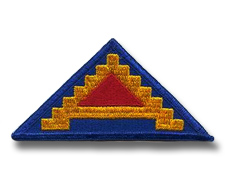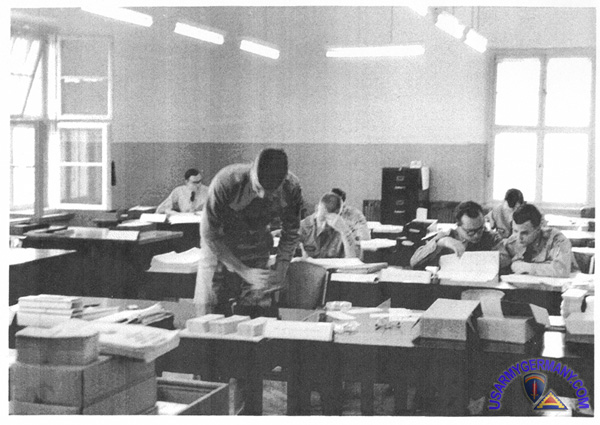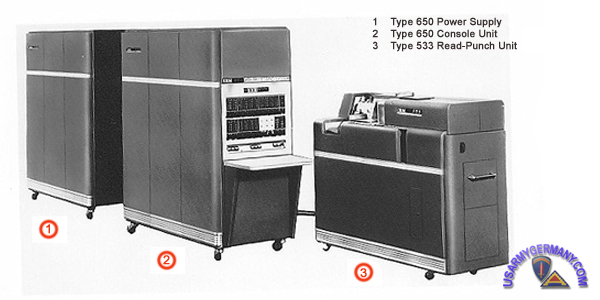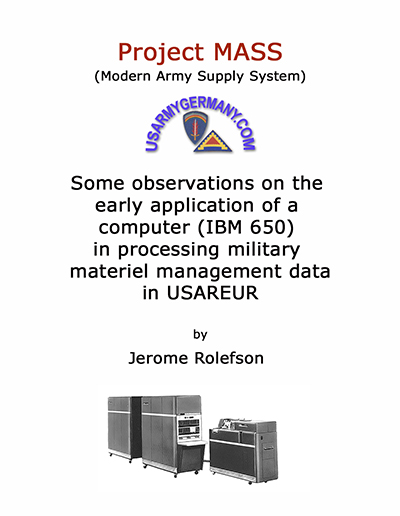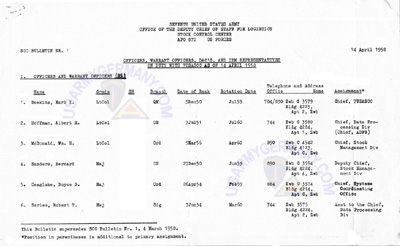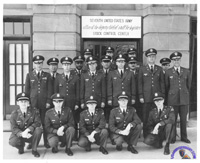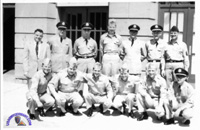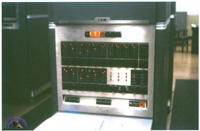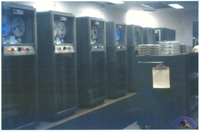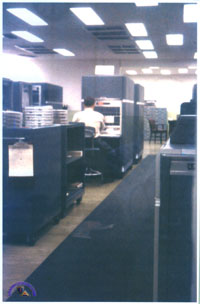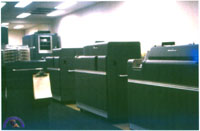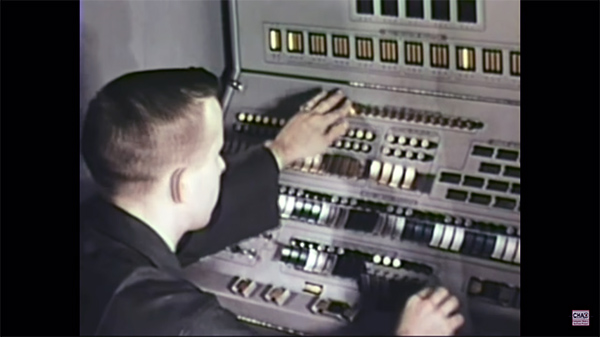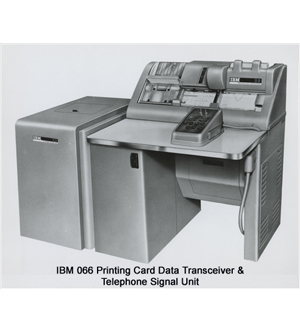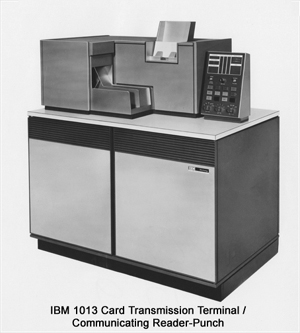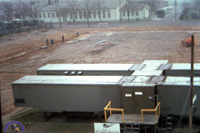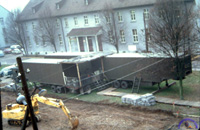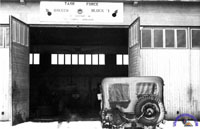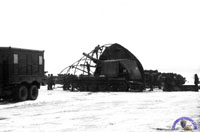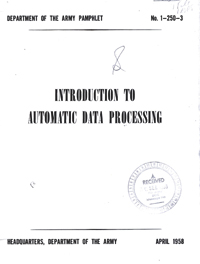|
Seventh Army Stock Control Center |
||||
|
|
||||
|
||||
|
|
||||
| 7th Army Stock Control Center | ||||
|
||||
| 1956 | ||||
| (Source: STARS & STRIPES, August 3, 1956) | ||||
| The test of US Army's Modern Army Supply System project was officially kicked off on July 2, 1956. Ordnance and Chemical were the first two technical services to initiate their tests. Officer in charge of the project at HQ 7th Army (Vaihingen) is Maj Harold E. Maier, Chief of the Supply Section, G-4, HQ 7th Army. The project calls for implementing a revised stockage plan where only fast-moving repair parts are stored in depots within the theater, while non-stocked (less frequently requested) items are requisitioned directly from depots in the States. The formerly slow pace of the supply system used by US Army forces overseas is being streamlined through the extensive use of electrical transmissions (see the article on the MASS Platoon of the 97th Sig Bn). Prior to the implementation of Project MASS, 7th Army depots stocked about 400,000 items. With the housecleaning (elimination of less freqently requested items from the depots) allowed by Project MASS that number is being reduced to about 50,000 items. In addition, rapid transportation of the repair parts requisitioned from stateside depots is designed to get the parts to the using unit within 20 days. 7th Army Stock Control Center, Vaihingen -- Chief of the center is Maj Frank B. Huntley; |
||||
| (Source: STARS & STRIPES, May 29, 1958) | ||||
| Planning for the Army's new logistics system was begun in 1952; Project MASS went into field test operation in July 1956 at 7th Army in Germany. That field test ends officially on June 30, 1958 when it goes into full operation (probably under a new name). The heart of the new logistics system is its transceiver communications system, linked with the IBM 650 computer system (or in Wikipedia). This system eliminates hand-written paperwork for supply items that are shipped from the US to the 7th Army. The transceiver is an electronic machine operated at the DSU (Direct Support Unit) level - the machine codes the item required and transmits the request to the 7th Army SCC. The SCC refers the request to one of six BASEC depots. If the item is on hand, it will be shipped by the depot to the requesting DSU. If not, SCC passes the request via transceover to the Overseas Supply Agency in the US. Here it is passed on via tranceiver to one of the Army depots in the US. If the item is shipped from the US depot by plane, it will arrive at Rhein-Main AB and then trucked or airlifted to the DSU. (Some items (e.g. special weapons items) are sent (US to Europe) on priority "blue-streak" requisitions within hours after receipt of the request.) If the item is shipped by sea, it will arrive at Bremerhaven and from there expressed to a ComZ depot. From there it will be forwarded to the DSU. The "brains" of the new logistics system is an IBM 650 located at the 7th Army SCC. This system processes data on magnetic tapes instead of using the older method of punched cards. OIC of the computer is 1st Lt Harry S. White. The 7th Army SCC is expecting a replacement for the IBM 650 in the future - the MOBIDIC, a mobile data processing system. (See additional information on MOBIDIC on the COMZEUR Page.) Project MASS project officer is MAJ Harold E. P. Maier. CO of the 7th Army Stock Control Center in Zweibrücken is .... Chief of the Data Processing Division, 7th Army Stock Control Center, is Lt Col Albert R. Hoffman. |
||||
| (See articles on 7th Inventory Control Center.) | ||||
| (Source: Email from Jerome F. Rolefson) | ||||
I was one of the ten original Computer Programmers that developed the initial software for the IBM 650 Computer used in Project MASS. This occurred from May 1957 to May 1959. We were initially stationed at the 7th Army HQ. at Stuttgart and later moved to Zweibruecken in Germany.
In the Summer 1958, I was placed in charge of the computer program development effort with the title of ADPS Coordinator. My title was later changed to Chief, Development Office with responsibility for computer programming, EAM procedures and training. I reported to Lt. Col. Albert Hoffman. While organizing and discarding old files, I discovered clippings, photos, rosters, etc. from the 7th Army SCC. "Goggling", I found that there may be an interest in some of that history.
|
||||
|
||||
| 1959 | ||||
| (Source: Email from Dale Roberts, 7th Army SCC, 1959-1960) | ||||
| I was assigned to 7th Army SCC in Zweibrücken from February 1959 to August 1960. It was a shock when the 7th Army SCC came up on my screen. You did an outstanding job capturing the essence of that unit over 50 years ago. I joined the unit about 1 to 2 years after the photos were taken, but we were still in transition with dozens of US's (draftees!) pouring in. Most of the new US's were 23 to 24 and were replacing mostly RA's -- much younger. We didn't care much for the peacetime Army, but overall I believe we did an excellent job. I was assigned to study under PFC. Wood when I first arrived. I had scored high on their tests and LT. Colonel Seccomb (commander) thought I should be a programer. PFC Wood was a genius, but like most genius' had a few idiosyncrasies.. One of them apparently was an instant dislike for me. He was the main programmer, and the system depended on his ability. I was assigned to his room in the old SS barracks, and we were supposed to be inseparable.. He didn't see it that way, and wouldn't even talk to me. Luckily a couple of months later we moved across the road to new barracks. Wood went one way, I went the other. He was a short timer and left in April or May I believe. I had been assigned to Document Control and Audit division to understand the process, and I decided to stay there. My Boss was CWO Robert Belchwender. The Company Commander was Anderson T Ledeaux (a Mustang and a very good man) |
||||
| 1963 | ||||
| MOBIDIC-7A (Mobile Digital Computer) | ||||
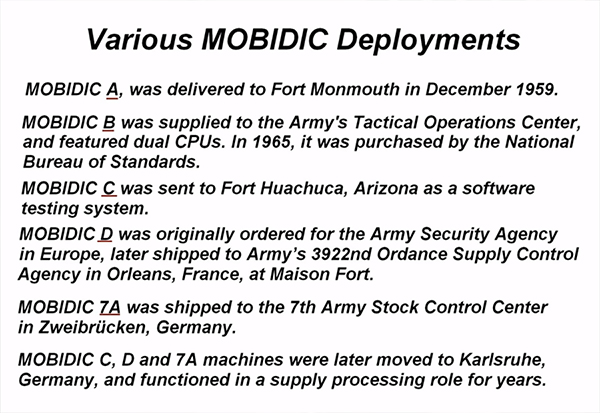 From the Computer History Archives Project video |
||||
| (Source: STARS & STRIPES, April 10, 1963) | ||||
| The first large-scale mobile computer system (called MOBIDIC) is recently been integrated into the 7th Army supply system and is now automatically processing supply data at the 7th Army Stock Control Center at Zweibruecken. (The tranition to the MOBIDIC system included a series of equipment acceptance and shake down tests that involved representatives from the contractor, Sylvania Electronics Products, Inc. and personnel of the 7th Army SCC. 7th Army SCC also wrote computers programs that run on the computer.) 7th Army SCC began operations in July 1958. At the time, the assigned mission of 7th Army SCC was to serve as the initial source for repair parts supply for 7th Army combat units and to provide timely supply status information to the staff and commander. (All of this was part of the Project MASS.) The MOBIDIC system is mobile and air transportable. It is contained in four standard 30-foot Army trailer vans. The vans contain |
||||
| (Source: Field Manual 29-10-1 (TEST), The Field Army Supply Management System, March 1967) | ||||
| APPENDIX C INTERIM ADP APPLICATIONS 1. Purpose and Scope 2. General Orientation Initially, the system consisted of a combination of manual and EAM operations, but these proved inadequate to meet the test objectives and for the production of timely, useful management information. In November 1957, a card-operated IBM 650 computer was installed and this was replaced by a magnetic tape unit in September 1958. Despite these evolutionary improvements, the system was hard-pressed to keep up with an ever-increasing workload and it was apparent that more speed and greater computer capacity were needed. One disturbing feature of this and the preceding systems was that they were immobile and, therefore, extremely vulnerable in the event of hostilities. To meet the requirements for increased speed, greater capacity, and mobility MOBIDIC-7A (MOBile DIgital Computer) was delivered to the center in February 1961.
|
||||
| MASS Platoon, 97th Sig Bn | ||||
| (Source: STARS & STRIPES, August 3, 1956) | ||||
MASS Platoon of the 97th Signal Battalion operates the Transceiver Division of the 7th Army Stock Control Center at Vaihingen, Germany. This is the nerve center of Project MASS. The operators of the platoon work in a long building with many transceivers and other business machines that operate around the clock. If the part is determined to be available, a "picking tag" card is made from the original requisition card and sent by transceiver to the appropriate depot ordering the part to be sent to the DSU. |
||||
| 7th Army Inventory Control Center | ||||
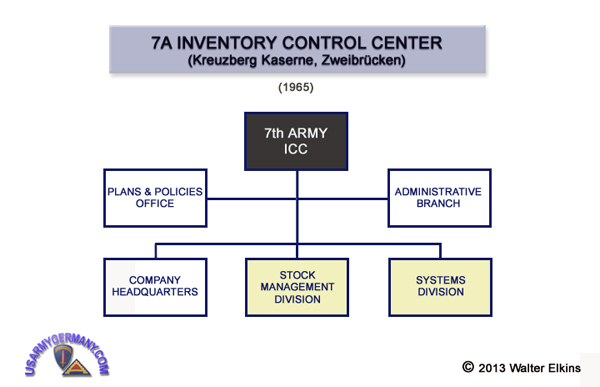 Fig 1: 7th Army Inventory Control Center organization, 1965 |
||||
| (Source: Field Manual 29-10, Supply Management in the Field Army, July 1965) | ||||
| INVENTORY CONTROL CENTER ORGANZATION & OPERATIONS (doctrine) 1. Composition The inventory control center (TOE 29-402) is organized along functional lines, into center headquarters, mission elements, and a detachment headquarters. These elements, shown in figure 1 (above), are discussed in the following paragraphs. 2. Center Headquarters
3. Company Headquarters
4. Stock Management Division
5. Systems Division
6. Transceiver Support * Stock Management Division operating branches: Electronic Branch; General Materiel Branch; Mobility Branch; Weapons & Munitions Branch. |
||||
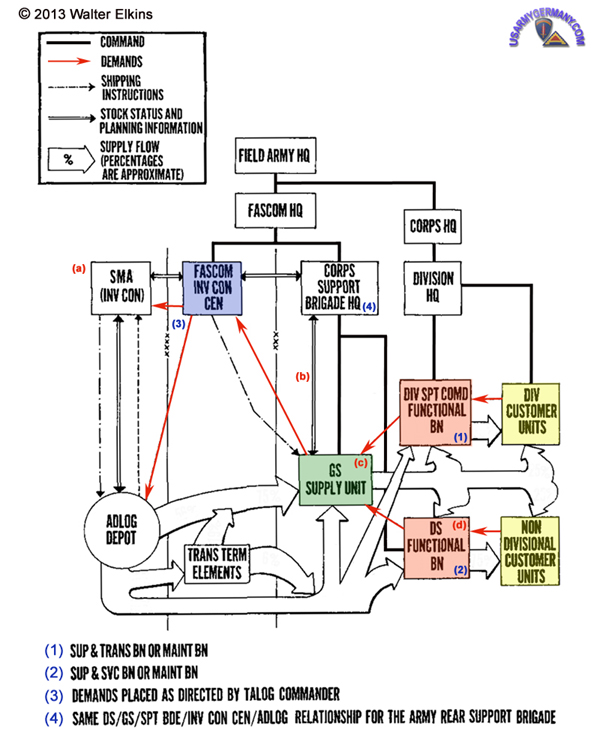 FM 54-4 (1965): Supply flow - classes I, II, III (packaged), and IV supplies |
||||
| (Source: Field Manual 54-4, The Support Brigade, July 1965) | ||||
| Flow of Supply (doctrine) The above schematic illustrates the flow of classes I, II and IV (less medical and missile peculiar), and III supplies within the combat zone, the transmission of stock status information, and the flow of demands and future planning data. Approximately a fourth of all dry cargo will probably be reshipped in the army service area through a transportation terminal or general support unit because of the need to change modes of transport. Handling patterns for specific items may be modified as necessary with throughput from COMMZ the ideal. Because it must operate with currently available equipment, the system is based on key punch machines at direct support and general support group level; however, automatic data processing systems will be introduced as they become available. Webmaster note: the schematic was modified to take into consideration that the support brigades in the 7th Army SUPCOM were tailored - in peacetime - without general support and direct support groups, an intermediate level of command between brigade headquarters and the functional battalions. (a) ADLOG (Advanced logistical command) Inventory Control was replaced by the SMA (Supply & Maintenance Agency) ICC. (b) GS Support Groups were removed. (c) GS Support Group Supply Unit was replaced by GS Supply Unit. (d) DS Support Group Functional Bn was replaced by DS Functional Bn. |
||||
| (Source: Field Manual 54-3, The Field Army Support Command, June 1965) | ||||
| Supply Operations - Requisitioning (doctrine) Requisitioning procedures and documents are described in AR 725-50. The requisition normally used for supplies other than bulk fuel and ammunition is the DA Form 2765 in either manual or machine-card form. In routine supply transactions, this form is usually filled out manually by the requisioning unit, converted to a punched card at the general support level, and transceived from that level to the inventory control center. |
||||
| 1964 | ||||
| (Source: STARS & STRIPES, March 14, 1964) | ||||
| There are two MOBIDIC computers in USAREUR - one is installed at the COMZ Supply and Maintenance Agency in Orleans, France; the other is located at Zweibrücken, Germany, and supports the 7th Army ICC. The MOBIDIC at Zweibrücken was recently upgraded with the expansion of the computer's memory to allow for more programming. During the week-long retrofit, SMA's MOBIDIC processed the ICC's parts replacement requests that came in from the 25 (custopmer) sites. The ICC computer has been in operation since late 1961. Once-a-month the 7th ICC computer is taken down for 16 hours for standard maintenance. |
||||
| 1965 | ||||
| (Source: Email from Vernon M. Danielsen) | ||||
| Your listing of 7th Army Communications Command units leaves out the US Army Tactical Data Unit.
This combined the former 7th Transceiver Detachment, headquartered in Zweibruecken and later Karlsruhe, handling live logistics traffic,
with a unit whose name I can't remember, located in Heidelberg supporting 7th Army. The TDU was formed in 1967. It was commanded by Cpt Fox, with a Cpt Casey and later myself as operations officer. The 7th Transceiver Detachment (abbreviated 7 Xcvr Det for mail addressing) sent live logistical traffic from 21 (or so) sites in southern Germany to the 7th ICC in Zweibruecken, and later in Karlsruhe after DeGaulle pushed NATO out of France. That's also when COMZ moved to Zweibruecken. The other unit was a separate network of a transceiver at each corps which sent tactical data - front line trace primarily - back to USAREUR HQ in Heidelberg. History of my association with 7th Army: |
||||
| 1. I attended the Army Automatic Data Processing school (ADPS) at Fort Monmouth NJ during the middle of 1964 … I believe August to October. That qualified me with an MOS of ADP Specialist. I believe the MOS was 2402. I am not sure of that. I was a Lieutenant in the Signal Corps and a Regular Army Officer. I have a BS in electrical engineering from Purdue University and graduated in 1962. At Purdue, I specialized in electronics, communications and control systems. 2. After the ADP school at Fort Monmouth, I was assigned to the 7th Army Inventory Control Center (ICC) and joined the unit in December 1964. The commanding officer of the ICC was a “branch immaterial” colonel. It turned out that he was a Signal Corps officer. I don’t remember his name. It may come to me. Perhaps Dick can remember it. 3. I was to be a computer systems analyst-programmer for the Army’s Mobile Digital Computer (MOBIDIC) that processed supply transactions for the inventory control system for 7th Army. 4. The ICC changed that and decided that I should be a product line manager for electronic and communications inventory. They sent me to the Army Training Center in Murnau Germany for course in inventory management. 5. The ICC was responsible for a digital data communications network that covered 7th Army in southern Germany. There were approximately 26 stations in the network at the major military installations and the supply depots. The network was staffed by soldiers assigned to the ICC and “attached” to the military units that the network supported for billets, food and some administrative support. However, they were assigned to the 7th ICC. 6. This network had some “operational challenges” due to outdated equipment, training and the widespread dispersion of the staff. The ICC was not in the “business” of operating a communications network. 7. With my background, expertise and electronics degree, I was placed in charge of the data communications operation. We called it the transceiver section. It was a section of the organization of the ICC. 8. The soldiers in the field were responsible daily for keypunching the supply transactions into 80 column punched cards. The transmitted the punched cards to the ICC daily in the evening through the communications network. The ICC processed the supply transactions and created material release orders that were transmitted from the ICC to the depots or the ICC created new requisitions to be transmitted to COMZ in France for those items not in stock in 7th Army depots. 9. The keypunch machines were IBM off the shelf commercial machines. I believe the model number was 028. The transceiver equipment was off the shelf data communications equipment. I believe the model numbers were 066/068. They operated at a speed of approximately 8 to 10 (80 column) cards per minute … the equivalent of approximately 100 bits per second (baud) … over a combination of Army owned and operated communications lines and Deutches Bundespost leased circuits. They were voice grade and specification circuits. Where possible we specified “conditioned circuits” that were supposed to be of higher quality and lower noise than “standard voice circuits.” The implementation of this specification was spotty at best. 10. The transceiver network and operation were badly in need of an upgrade in staff qualifications, training, staff “command control”, equipment speed, accuracy and technology, and communications standards. 11. Working with the commanding officer of the ICC, the 7th Army Signal Officer and their staffs we decided on a configuration of the organization and a concept for the operation of the data communications network. We implemented a new organization. This probably occurred sometime around 1965. We implemented the following. 12. The network became part of the worldwide defense communications network (WWDCN). The hub of the network, co-located with the ICC in Zweibrucken Germany at Kreuzberg Kaserne, became a major relay in the WWDCN and was designated RUFV. We had a connection to the major relay in France (either Verdun or Orleans … I don’t recall which) for communications of supply transactions to COMZ. I believe their designation was RUFF. The network consisting of the stations operated by the 7th Transceiver Detachment was part of the WWDCN and each station had a designation and a station identification under RUFV. 13. The 7th Transceiver detachment operated under the standards of the WWDCN using JANAP 128. We were a “data only” network, though we did have one secure teletype circuit to COMZ. 14. Sometime around 1966 we upgraded the system to “high speed” operation. We installed 100 (80 column) card per minute (1200 bit per second – baud) transceivers. They were off the shelf, commercial IBM machines … I believe they were IBM 1013 at the high volume locations (relay stations and depots) and we retained lower speed equipment at the terminals. Modems were “frequency shift key (fsk) technology and were primarily Lenkurt off the shelf commercial equipment. We also installed peripheral IBM and other manufacturers’ equipment for administrative functions. We also implemented detailed written instructions and formalized the training programs at all levels. 15. IBM technical personnel were assigned for maintenance support and training assistance. There was a maintenance contract with IBM. 16. In late 1966 (December time frame) I was due to be reassigned to Fort Gordon GA. My tour was extended to February or March 1967 with the specific assignment to move the major relay (RUFV) of the 7th Transceiver Detachment to Karlsruhe Germany. This was due to the withdrawal by President (General) Charles DeGaulle of France from NATO. COMZ was moved to Germany and elements were moved to Zweibrucken and Kreuzberg Kaserne. The ICC was also moved to Karlsruhe. Dick Harris played a major role in making this move happen. 17. From December 1966 to March 1967 I coordinated the move of personnel and equipment to Karlsruhe and the reconfiguration of the network, installation and testing of circuits and equipment. The new network control station RUFV was pretty much operational when I left in early 1967. 18. The network of the 7th Transceiver Detachment was exclusively in fixed station facilities (buildings) and exclusively used commercial, off the shelf equipment. We had no militarized data communications equipment. There was some discussion about mounting data communications equipment in vans and using Army circuits for the “last few miles” of communications connectivity for the Infantry and Armored Divisions, but this never went anywhere. Technology and the pressures of making the fixed station network work were all we could accomplish at the time. 19. The network consisted of approximately 26 stations. I might be able to come up with (several, many or most of) the locations from memory, but please don’t tax me too much. 20. I didn’t have anything to do with the tactical data unit at the corps. ADDITIONAL INFORMATION (Source: information submitted by Vern Danielsen & Dick Harris) I (Dick Harris) was an 0221 - Comm Center Officer. I was assigned in my MOS to 440th Signal Battalion Then, when the batallion was levied for a lieutenant to replace Lt. Ostrander who was rotating out, I was reassigned as the only single (thus, moveable) officer with a technical background in the batallion. Vern asked for a EE, but I had a physics degree, which was judged close enough. 7th Inventory Control Center 7th ICC was a large product management and inventory control operation with a lot of people and many functions not done by the MOBIDIC computer. Today of course many of those would be on the computer. I know the ICC handled repair parts, fuels and toilet paper. Big dust-up when a depot stored toilet paper outside. The comment was passed that you could wash and wipe at the same time. I think we handled Classes II (tools, tents, TP, etc.), III (POL), IV (concrete, barbed wire), and IX (repair parts). The MOBIDIC-7A digital computer (assigned to 7th Army SUPCOM) was installed on three trailers that were able to be towed by tractors in an 18-wheeler configuration. Commercial power for the computer system was provided with a motor generator set to convert the German power … primarily the 50 Hz to 60 Hz … and to provide some air conditioning. I believe they also had backup generators. MOBIDIC used the Fieldata programming language. The MOBIDIC created punched card, material release orders (MROs) that were sent to the depots. I believe the ICC also prepared a status card that was sent back to the unit that created the original supply transaction. I also believe the depot created a confirmation … perhaps called a shipping order … that was sent to the ICC. If the depot was out of stock of an item or if the item was not one stocked at a 7th Army depot, the ICC prepared a request that was sent to COMZ to be filled. If COMZ couldn’t fill the request they forwarded it to the next higher level … presumably in the US. The supply requisitions were prepared manually, hand written in the field by the maintenance and supply units (in the division or support brigade area) and delivered to the “field location” transceiver site. The operator there key punched the transaction into IBM 80 column cards. These cards were batched and received header and trailer cards with routing information and a card count. These batches were transmitted to a relay station where they were consolidated and retransmitted to Zweibrücken. The batches were received at Zweibrücken, card counts checked and the cards were carried to the ICC. This was manual, physical movement of the cards documented by logs. The ICC processed the supply transactions. They were primarily requisitions, but, as I recall, some were requests for status or follow up. |
||||
|
||||
| Transceiver Section The Transceiver section was in a communications center located in the 7th ICC building on Kreuzberg Kaserne, Zweibrücken. The data transceiver network consisted of two relay sites and a network of subordinate transceiver sites that fed into the relays. One of the relays was at Mannheim and the other one was at Ludwigsburg, north of Stuttgart. (From a communications standpoint Zweibruecken, and later Karlsruhe, was a major relay, with more than one signal path to the rest of the world. The two relay sites were minor relays.) The network consisted of high speed–high volume and low speed links. The high speed–high volume links were from Zweibrücken to the two relay stations in the 7th Army network and to COMZ in Orleans (where the Supply & Maintenace Agency ICC was located). The low speed links in Germany were 066 – 068 transceivers. There were one or more (at each site) depending on the volume. There were several 066 – 068s at the relay stations and were connected to the circuits to each remote site via a switchboard. The “technical staff” in Zweibrucken fabricated these switchboards from commercial parts and were “higher quality – lower loss” than the tactical switchboards in the Army inventory. All circuits were full time dedicated circuits … i.e. not on call or dial up. I (Vern Danielsen) believe there were two 1013s at each of the depots. That would make sense for redundancy, but I’m not positive of that. There were 4 1013s at the Zweibrücken site. There were multiple 066 – 068s at the relay sites and the remote sites had one or perhaps more depending on volume. I am sure that some remote sites had only one 026 keypunch and one 066 – 068 transceiver because we often had a difficult time if the unit was down until the IBM maintenance technician got there to make the necessary repairs. The depots did not have their own transceiver sections. In the early days of my tenure, these transceiver sites were the responsibility of the ICC and the people were assigned to the ICC (listed on the ICC TOE) and attached to a local unit for food, lodging, admin etc. Later when the 7th Transceiver Detachment was formed all of the network stations … 2 relay sites and the other 24 plus or minus remote sites … were part of the 7th Transceiver Detachment under the 7 th Signal Group TOE. Each of the sites … including the one in Zweibrucken was attached to a local unit for food, lodging etc. The personnel at the remote sites were assigned (or attached) to a Signal unit … company, battalion etc. … for all support. I had operational control and the local unit had command control. The Transceiver Detachment had enlisted men with MOS 74Dxx -- Info Systems Operator -- which was a much better fit than the signal corps MOS used to staff the Pirmasens AUTODIN station. They had 72Bxx -- Comm Center Specialist -- who were teletype operators. At some point I went along on a training mission which we sent to Pirmasens to help with their in-station traffic (decks of punched cards) handling procedures. |
||||
| 1967 | ||||
| (Source: STARS & STRIPES, June 9, 1967) | ||||
| (See COMZEUR Page for more information on the 7th ICC and MOBIDIC) Mobile Digital Computer (MOBIDIC) The 7th Inventory Control Center, Seventh Army Support Command, moved from Kreuzberg Kaserne, Zweibrücken to Gerszewski Barracks, Karlsruhe in Dec 1966. With that transfer to a new home station, the unit's MOBIDIC computer complex needed to be moved also. The MOBIDIC computer is used to automate the processing of supply requisitions from throughout 7th Army. At Zweibrücken, the computer complex originally consisted of four vans that were interconnected with a stationary, permanent structure. With the move, a modification was applied once it was set up in Karlsruhe. The permanent structure was replaced by a fifth van. Four connecting doors were cut into the intervan structure and it was sealed to prevent humidity, snow, rain and dust from interfering with the sensitive computer components. Also, generators were set up to power the complex as the post had no commercial power. With the modification, the MOBIDIC has now become 100 percent mobile. |
||||
(Source: Email from Peter Hauck) |
||||
My Recollections of Army service: In March of 1967 I was commissioned as a 2nd Lt. through the ROTC program at Eastern Washington State College in Cheney, Washington. In April I reported to Aberdeen Proving Grounds, Maryland for Basic Ordnance Officer School and Maintenance Officer School before reporting to HQ & A Co, 51st Maint Bn (DS) at Sullivan Barracks, in Mannheim, Germany in late September 1967. While there I was assigned as Svc & Evac Plt Ldr, but most of my workload was as Motor Officer. During that fall we were involved in a project to return 10-ton trucks to the owning units. It seems that a large percentage (60+) of these trucks were sitting in maintenance yards like ours with bad/broken engines, some for over a year. (Reference Col Hobar’s comments on the logistics problems moving from France in Operation FRELOC.) Lost engines had been located and a 1st Spt Brigade decision was made to work overtime to get the majority of trucks roadworthy and back to units before Christmas. I remember our personnel working 12 hr days – 6 days a week for 8-10 weeks. Our Battalion alone (in Mannheim and Karlsruhe) had about 180 of the trucks in our repair yards “awaiting parts”, but it was a theater-wide problem. The next May I was sent for classes to Oberammergau and Vilseck, and the week I returned I got orders to 7th ICC, with 3 days to report. In May 68 the Materiel Management Company was formed by 7A SUPCOM at 7th ICC as an offshoot of the previous year’s problems with losing/finding repair parts. It was located in the 4th floor/attic of the building, and a footnote to the 7th ICC primary mission. The theory was that owning units would send in punch cards with maintenance data to 7 ICC to identify problems with all types of equipment. We would compile and prepare reports to be sent back through their commands to the units. The goal was that on a weekly basis each level of command would see a report on their assets’ maintenance status and could highlight problem areas with specific pieces of equipment. My initial task was to come up with a code that could identify all the units and their levels of command. It ended up being a 6-digit code as there were 6 levels of command. It was used to sort the data reports to go back to the units for updating. The rest of the time was spent correcting errors on the equipment lists and redoing them before sending them out. In January of 1969 I was sent to Oberammergau again to an ADP orientation class. In March the unit was split in two, half supporting V Corps, and half supporting VII Corps. I went with VII COSCOM-MMC when it relocated to Panzer Kaserne in Boeblingen in May. The V COSCOM-MMC stayed at Karlsruhe and would go to the IG Farben Bldg in Frankfurt later with the “stationary” IBM 360-40 computer. The “mobile” 360-40 unit came to Boeblingen. In Karlsruhe I had been living off post with another officer who I originally met at APG, and we scouted out another off-post apartment in Boeblingen. But when we actually moved the housing office wouldn’t give us a statement of non-availability, so we ended up in the BOQ by the O’Club sharing a bathroom. Later I was able to move to an empty field grade BOQ which was in the water tower. I had the lowest apartment of 5. Again in November 1969, I was given a 3 day notice move to become CO of C Co, 71st Maintenance Bn in Bamberg. In February 1970 I was detailed to command a detachment “Task Force Breech Block I” supporting a VII Corp Arty exercise, “Carmine Leg” at Graf. We operated at the Vilseck side of the training area, and the detachment was made up of personnel from all over the VII Corp area. This year REFORGER was canceled so VII Corp Arty grabbed the time slot. I spent many evenings at the Graf O Club doing liaison with the commanders of the units we supported. Our most exciting occurrence was finding our maintenance tent on top of a tracked gun in the middle of the hardstand one morning. It had been staked at the edge of the hardstand and used to shelter engineering equipment brought in for repairs. During the night a strong wind came up from behind it and “flew” it onto the gun. I remained in Bamberg as CO until relieved in Aug 1970, when my 3-year active duty commitment was completed. After returning to CONUS, I converted to inactive reserve status until discharge in March 1973. |
||||
| Project MASS (Modern Army Supply System) July 1956 - June 1958 | ||||
| (Source: DA Pam 1-250-3, April 1958 - via Jerome Rolefson) | ||||
|
||||
| Related articles & materials found in the Technical Services sections of the website | ||||
| Related
Links |
||||
